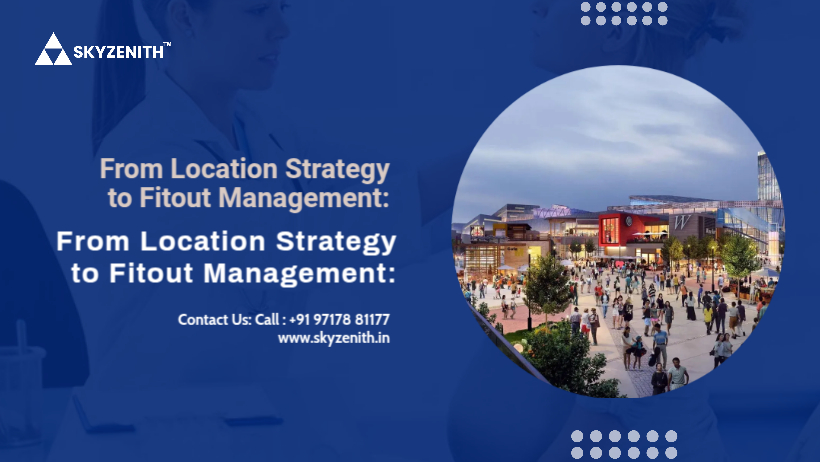
-
Skyzenith
- September 5, 2025
From Location Strategy to Fitout Management: Complete Design Solutions for Modern Mall Development
The retail industry is undergoing a remarkable transformation. As consumer expectations evolve and urban spaces grow denser, malls have emerged as more than shopping centers, they are lifestyle destinations. To meet this demand, developers and investors must adopt a holistic approach that integrates location strategy, fitout management, and innovative design solutions. These factors not only influence a mall’s market positioning but also determine long-term profitability, footfall, and customer experience.
In today’s competitive retail ecosystem, the success of mall development relies on creating spaces that are strategically located, efficiently managed, and aesthetically designed. This article explores the complete journey of mall development, from location planning to fitout management, and highlights how design solutions shape thriving retail environments.
Location Strategy: The Foundation of Successful Mall Development
The first step toward creating a successful mall lies in choosing the right location. A mall’s catchment area defines its target audience, footfall potential, and brand positioning.
Key Considerations in Location Strategy:
- Catchment Analysis: Identifying the population size, income levels, and lifestyle preferences within a defined radius.
- Connectivity: Easy access via highways, metro, airports, and local transportation ensures higher visitor numbers.
- Competition Mapping: Studying existing malls, high streets, and retail formats to position the project uniquely.
- Future Growth Potential: Evaluating upcoming infrastructure projects, residential townships, and commercial hubs in the area.
For example, a mall positioned near premium residential communities and educational hubs attracts families, professionals, and students. Conversely, a project located in an industrial zone may fail to achieve desired footfall. Thus, a robust location strategy is not just about land, it is about foresight and positioning.
Design Solutions: Building Experiences, Not Just Spaces
Modern malls are designed to deliver more than retail, they are about experiences that combine shopping, dining, entertainment, and leisure. Smart design solutions help differentiate one mall from another and directly impact how long customers stay and spend.
Key Elements of Mall Design Solutions:
- Zoning & Category Mix
- Clear segmentation of retail, food, entertainment, and service areas enhances navigation.
- Anchor tenants like supermarkets or cinema halls drive consistent footfall.
- Clear segmentation of retail, food, entertainment, and service areas enhances navigation.
- Customer-Centric Layouts
- Wide atriums, open courtyards, and interactive spaces improve the overall visitor experience.
- Vertical circulation with escalators and lifts ensures seamless movement.
- Wide atriums, open courtyards, and interactive spaces improve the overall visitor experience.
- Sustainable Architecture
- Green landscaping, natural light, and energy-efficient designs lower operational costs.
- Incorporating eco-friendly materials enhances the mall’s appeal to conscious consumers.
- Green landscaping, natural light, and energy-efficient designs lower operational costs.
- Technology Integration
- Smart directories, digital signages, and app-based navigation enrich customer convenience.
- Intelligent HVAC and lighting systems optimize energy usage and comfort.
- Smart directories, digital signages, and app-based navigation enrich customer convenience.
By integrating design thinking with retail psychology, developers can create malls that resonate with diverse consumer groups and encourage repeat visits.
Fitout Management: Bringing Design to Life
Once the design and zoning are finalized, the next critical stage is fitout management. This involves converting raw spaces into functional retail environments aligned with the brand’s identity and operational needs.
Importance of Fitout Management:
- Customization: Each brand has unique design requirements, from façade aesthetics to display arrangements.
- Consistency: Ensuring every store aligns with mall-wide safety codes, branding standards, and technical guidelines.
- Timely Delivery: Coordinating with multiple stakeholders to complete projects within deadlines.
- Quality Control: Maintaining high construction standards while balancing cost efficiency.
Fitout management plays a pivotal role in ensuring that tenants can seamlessly transition into operational spaces, thereby reducing delays in mall openings and ensuring quicker returns on investment.
The Interplay of Strategy, Design, and Execution
A successful mall project is not about one element but about the synergy between location strategy, design solutions, and fitout management. For instance:
- A great location without a strong design may not sustain footfall.
- An innovative design without fitout efficiency may delay launch timelines.
- Strong execution without a robust catchment plan may reduce commercial viability.
When these three dimensions work in harmony, the mall evolves into a sustainable, profitable, and consumer-loved destination.
Emerging Trends in Mall Development
The mall development sector continues to innovate. Some of the most promising trends include:
- Mixed-Use Developments: Integrating office spaces, co-working areas, and residential towers with malls.
- Experiential Retail: Hosting events, exhibitions, and cultural activities to attract diverse audiences.
- Wellness Zones: Yoga centers, spas, and wellness cafés catering to health-conscious consumers.
- Phygital Integration: Bridging physical and digital shopping experiences with AR/VR technologies.
- Community Spaces: Designing malls as hubs for social interaction beyond retail transactions.
These trends highlight that malls of the future are not just about shopping, they are about lifestyles.
Conclusion
Mall development is a complex yet rewarding endeavor that requires a complete approach, starting from location strategy, through design planning, to fitout management. Developers who understand this integration can create malls that stand out as cultural, social, and commercial landmarks.
By combining the right location advantage, design excellence, and execution expertise, malls can ensure high footfall, tenant satisfaction, and long-term profitability.
SkyZenith
At SkyZenith, we specialize in providing end-to-end solutions for mall development and management. From strategic location analysis to category mix planning, design solutions, and complete fitout management, our expertise ensures that every project is delivered with precision and excellence. With a proven track record of transforming commercial spaces into thriving destinations, we focus on innovation, sustainability, and customer experience.
For inquiries:
Address: Spaze Platinum, Sohna Road, Gurgaon
Email: Hemraj.dabur@skyzenith.in
Phone: +91 97178 81177
Website: www.skyzenith.in